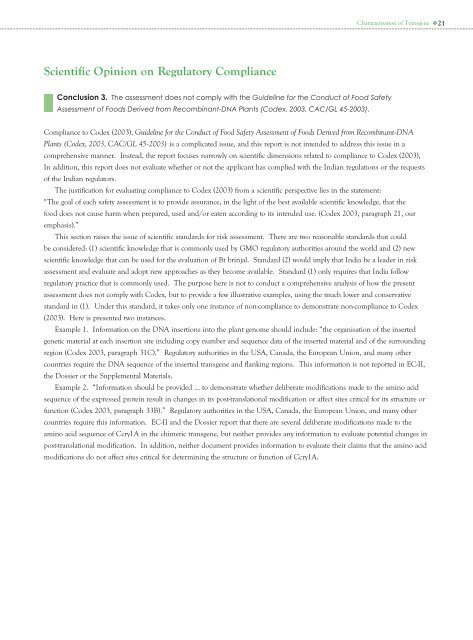Bt Brinjal The scope and adequacy of the GEAC environmental risk assessment
Bt Brinjal: The scope and adequacy of the GEAC ... - Down To Earth
Bt Brinjal: The scope and adequacy of the GEAC ... - Down To Earth
- No tags were found...
Create successful ePaper yourself
Turn your PDF publications into a flip-book with our unique Google optimized e-Paper software.
Characterisation <strong>of</strong> Transgene 21Scientific Opinion on Regulatory ComplianceConclusion 3. <strong>The</strong> <strong>assessment</strong> does not comply with <strong>the</strong> Guideline for <strong>the</strong> Conduct <strong>of</strong> Food SafetyAssessment <strong>of</strong> Foods Derived from Recombinant-DNA Plants (Codex, 2003, CAC/GL 45-2003).Compliance to Codex (2003), Guideline for <strong>the</strong> Conduct <strong>of</strong> Food Safety Assessment <strong>of</strong> Foods Derived from Recombinant-DNAPlants (Codex, 2003, CAC/GL 45-2003) is a complicated issue, <strong>and</strong> this report is not intended to address this issue in acomprehensive manner. Instead, <strong>the</strong> report focuses narrowly on scientific dimensions related to compliance to Codex (2003),In addition, this report does not evaluate whe<strong>the</strong>r or not <strong>the</strong> applicant has complied with <strong>the</strong> Indian regulations or <strong>the</strong> requests<strong>of</strong> <strong>the</strong> Indian regulators.<strong>The</strong> justification for evaluating compliance to Codex (2003) from a scientific perspective lies in <strong>the</strong> statement:“<strong>The</strong> goal <strong>of</strong> each safety <strong>assessment</strong> is to provide assurance, in <strong>the</strong> light <strong>of</strong> <strong>the</strong> best available scientific knowledge, that <strong>the</strong>food does not cause harm when prepared, used <strong>and</strong>/or eaten according to its intended use. (Codex 2003, paragraph 21, ouremphasis).”This section raises <strong>the</strong> issue <strong>of</strong> scientific st<strong>and</strong>ards for <strong>risk</strong> <strong>assessment</strong>. <strong>The</strong>re are two reasonable st<strong>and</strong>ards that couldbe considered: (1) scientific knowledge that is commonly used by GMO regulatory authorities around <strong>the</strong> world <strong>and</strong> (2) newscientific knowledge that can be used for <strong>the</strong> evaluation <strong>of</strong> <strong>Bt</strong> brinjal. St<strong>and</strong>ard (2) would imply that India be a leader in <strong>risk</strong><strong>assessment</strong> <strong>and</strong> evaluate <strong>and</strong> adopt new approaches as <strong>the</strong>y become available. St<strong>and</strong>ard (1) only requires that India followregulatory practice that is commonly used. <strong>The</strong> purpose here is not to conduct a comprehensive analysis <strong>of</strong> how <strong>the</strong> present<strong>assessment</strong> does not comply with Codex, but to provide a few illustrative examples, using <strong>the</strong> much lower <strong>and</strong> conservativest<strong>and</strong>ard in (1). Under this st<strong>and</strong>ard, it takes only one instance <strong>of</strong> non-compliance to demonstrate non-compliance to Codex(2003). Here is presented two instances.Example 1. Information on <strong>the</strong> DNA insertions into <strong>the</strong> plant genome should include: “<strong>the</strong> organisation <strong>of</strong> <strong>the</strong> insertedgenetic material at each insertion site including copy number <strong>and</strong> sequence data <strong>of</strong> <strong>the</strong> inserted material <strong>and</strong> <strong>of</strong> <strong>the</strong> surroundingregion (Codex 2003, paragraph 31C).” Regulatory authorities in <strong>the</strong> USA, Canada, <strong>the</strong> European Union, <strong>and</strong> many o<strong>the</strong>rcountries require <strong>the</strong> DNA sequence <strong>of</strong> <strong>the</strong> inserted transgene <strong>and</strong> flanking regions. This information is not reported in EC-II,<strong>the</strong> Dossier or <strong>the</strong> Supplemental Materials.Example 2. “Information should be provided … to demonstrate whe<strong>the</strong>r deliberate modifications made to <strong>the</strong> amino acidsequence <strong>of</strong> <strong>the</strong> expressed protein result in changes in its post-translational modification or affect sites critical for its structure orfunction (Codex 2003, paragraph 33B).” Regulatory authorities in <strong>the</strong> USA, Canada, <strong>the</strong> European Union, <strong>and</strong> many o<strong>the</strong>rcountries require this information. EC-II <strong>and</strong> <strong>the</strong> Dossier report that <strong>the</strong>re are several deliberate modifications made to <strong>the</strong>amino acid sequence <strong>of</strong> Ccry1A in <strong>the</strong> chimeric transgene, but nei<strong>the</strong>r provides any information to evaluate potential changes inpost-translational modification. In addition, nei<strong>the</strong>r document provides information to evaluate <strong>the</strong>ir claims that <strong>the</strong> amino acidmodifications do not affect sites critical for determining <strong>the</strong> structure or function <strong>of</strong> Ccry1A.











